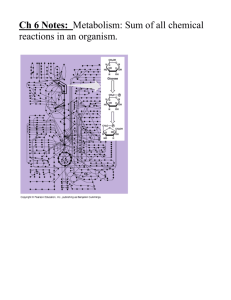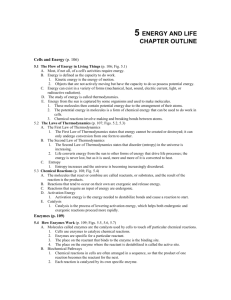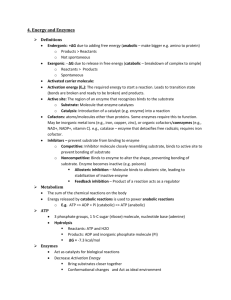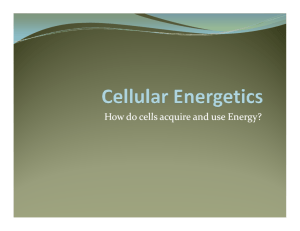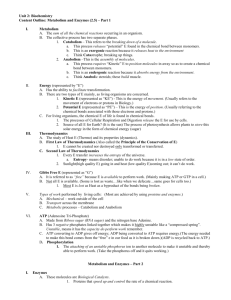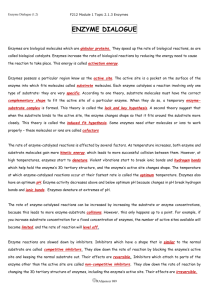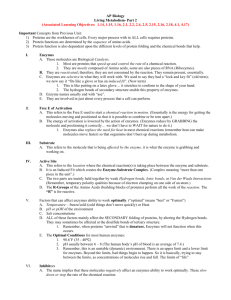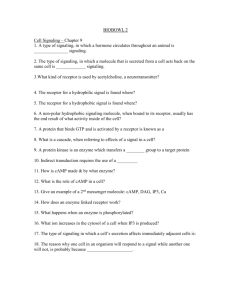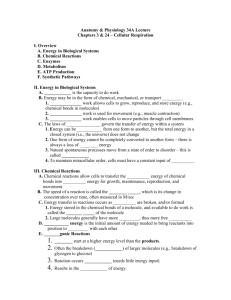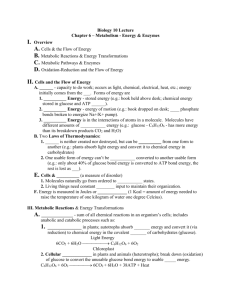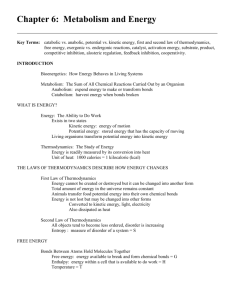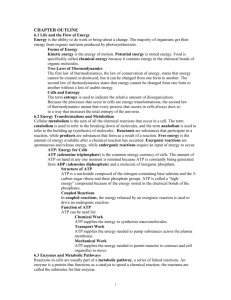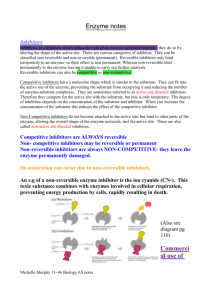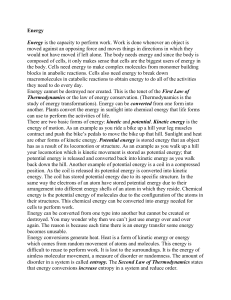File - notes
advertisement
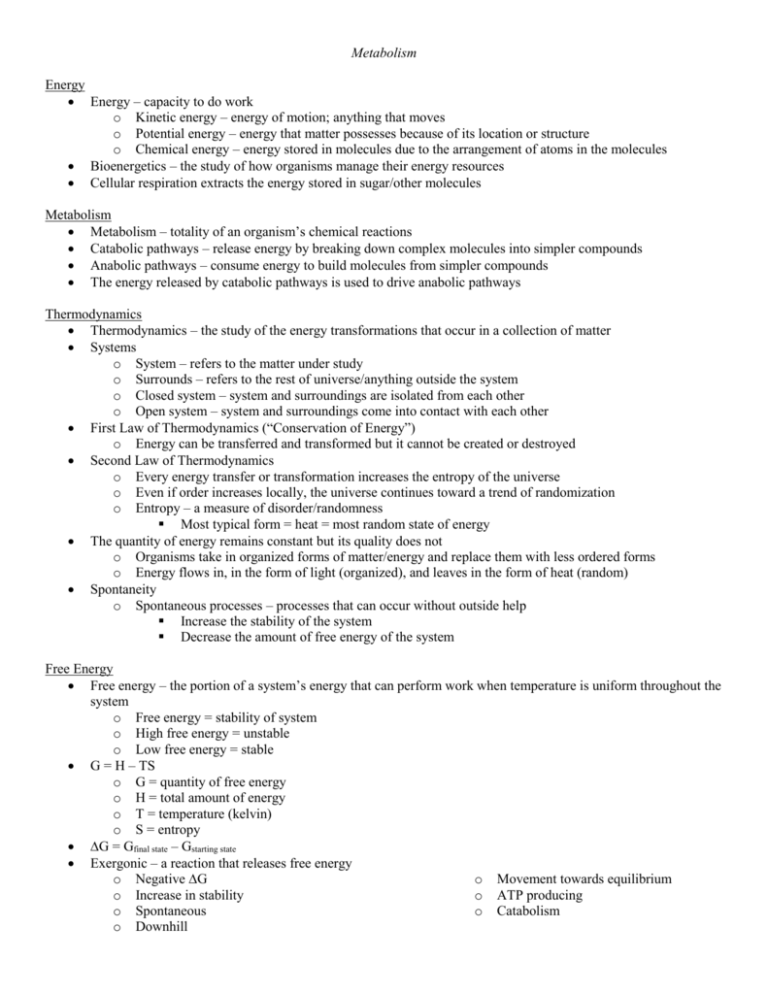
Metabolism Energy Energy – capacity to do work o Kinetic energy – energy of motion; anything that moves o Potential energy – energy that matter possesses because of its location or structure o Chemical energy – energy stored in molecules due to the arrangement of atoms in the molecules Bioenergetics – the study of how organisms manage their energy resources Cellular respiration extracts the energy stored in sugar/other molecules Metabolism Metabolism – totality of an organism’s chemical reactions Catabolic pathways – release energy by breaking down complex molecules into simpler compounds Anabolic pathways – consume energy to build molecules from simpler compounds The energy released by catabolic pathways is used to drive anabolic pathways Thermodynamics Thermodynamics – the study of the energy transformations that occur in a collection of matter Systems o System – refers to the matter under study o Surrounds – refers to the rest of universe/anything outside the system o Closed system – system and surroundings are isolated from each other o Open system – system and surroundings come into contact with each other First Law of Thermodynamics (“Conservation of Energy”) o Energy can be transferred and transformed but it cannot be created or destroyed Second Law of Thermodynamics o Every energy transfer or transformation increases the entropy of the universe o Even if order increases locally, the universe continues toward a trend of randomization o Entropy – a measure of disorder/randomness Most typical form = heat = most random state of energy The quantity of energy remains constant but its quality does not o Organisms take in organized forms of matter/energy and replace them with less ordered forms o Energy flows in, in the form of light (organized), and leaves in the form of heat (random) Spontaneity o Spontaneous processes – processes that can occur without outside help Increase the stability of the system Decrease the amount of free energy of the system Free Energy Free energy – the portion of a system’s energy that can perform work when temperature is uniform throughout the system o Free energy = stability of system o High free energy = unstable o Low free energy = stable G = H – TS o G = quantity of free energy o H = total amount of energy o T = temperature (kelvin) o S = entropy ∆G = Gfinal state – Gstarting state Exergonic – a reaction that releases free energy o Negative ∆G o Movement towards equilibrium o Increase in stability o ATP producing o Spontaneous o Catabolism o Downhill Endergonic – a reaction that uses up/takes in free energy o Positive ∆G o Decrease in stability o Nonspontaneous o Uphill ∆G = 0 means cell is dead o o o Movement away from equilibrium ATP requiring Anabolism High vs. Low Free Energy High Free Energy (unstable) Compressed spring Elevated water High concentration gradient ATP Low Free Energy (stable) Relaxed spring Level water Low concentration gradient Cellular work (uses ATP) o Mechanical (contractions of muscle cells) o Transport (pumping of substances across membranes o Chemical (building polymers) Structure o Nitrogenous adenine base o Ribose o 3 phosphate groups Phosphate bonds are weak because each phosphate has a negative charge Hydrolysis used to break bonds between phosphates Unstable molecule The energy from the hydrolysis is coupled directly to endergonic process by transferring the phosphate to another molecule (molecule is phosphorylated); molecule is removed and work occurs ATP can be renewed by re-adding/bonding the phosphates to the molecule remaining Enzymes General o Enzyme – a protein that changes the rate of a reaction without being consumed by the reaction o Substrate – reactants involved in reactions with enzymes o Substrate specific – each enzyme catalyzes specific substrates for specific reactions o Products – the substances that emerge from the enzyme after they are catalyzed o Allow reactions to occur at moderate temperatures o Form enzyme-substrate complex o Catalytic enzymes (aka proteases) vs. anabolic enzymes Activation energy o Activation energy – energy required to break bonds in the reactance molecules o Enzymes speed reactions by lowering activation energy (do NOT change ∆G) Structure o Active site – region where the enzyme binds to the substrate o Allosteric site – receptor sites for enzyme regulators o Induced fit – the enzyme changes its shape the fit the substrate more snuggly/comfortably Activators (kind of) + more o Activators – substances that trigger enzyme activity o Cofactor – a non-protein helper in catalytic activity (organic/inorganic, i.e. zinc, etc.) o Coenzyme – an organic molecule that is a helper in catalytic activity (vitamins) o Cooperativity – in enzymes with multiple catalytic subunits, binding by a substrate to one active site stabilizes favorable conformational changes at all other subunits Inhibitors o Inhibitors – substances that inhibit enzyme activity o Competitive inhibition – inhibitors that compete for admission to the active site o Noncompetitive inhibition – inhibitors that attaches to the allosteric site to deactivate the enzyme Factors that affect enzymatic activity (think in terms of collisions) o Substrate concentration (direct relationship, increase = increase) o Temperature (direct relationship) o Enzyme concentration (direct relationship) o Competitive inhibitors (inverse relationship, increase = decrease) o Denaturation (inverse relationship) Enzymatic rate of activity is highest at the beginning of the reaction because high number of substrate Enzymes shape affected by: o Salt concentration o pH o Activators o Temperature o Inhibitors
